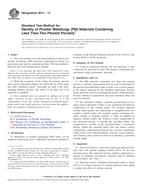Potrebujeme váš súhlas na využitie jednotlivých dát, aby sa vám okrem iného mohli ukazovať informácie týkajúce sa vašich záujmov. Súhlas udelíte kliknutím na tlačidlo „OK“.
ASTM B611-13
Standard Test Method for Determining the High Stress Abrasion Resistance of Hard Materials
Automaticky preložený názov:
Štandardná skúšobná metóda pre stanovenie vysokého napätia Oteruvzdornosť tvrdých materiálov
NORMA vydaná dňa 15.11.2013
Informácie o norme:
Označenie normy: ASTM B611-13
Poznámka: NEPLATNÁ
Dátum vydania normy: 15.11.2013
Kód tovaru: NS-7398
Počet strán: 6
Približná hmotnosť: 18 g (0.04 libier)
Krajina: Americká technická norma
Kategória: Technické normy ASTM
Kategórie - podobné normy:
Anotácia textu normy ASTM B611-13 :
Keywords:
abrasion, abrasion testing, cemented carbides, ceramics, high-stress abrasion, slurry, ICS Number Code 77.160 (Powder metallurgy)
Doplňujúce informácie
| Significance and Use | ||||||||||
|
5.1 The extraction of minerals from the Earth’s mantle usually requires fracturing rock with tools made from metals, but clad, overlaid, or covered in some fashion with hard materials. Drilling, crushing, and moving rock involves high-stress abrasion on the surfaces that make contact with the rock. The stresses are high enough to crush/fracture the rock. This test method simulates this condition, and it is used to screen new materials for these types of applications. It can also be used as a quality control tool for materials destined for high-stress abrasion applications: slurry pumps, comminution equipment, recycling choppers, demolition equipment, etc. 5.2 Most abrasion tests use low-stress abrasion. The abrasive stays relatively intact during testing. High-stress abrasion simulates applications where the force between an abrasive substance and a tool/component will be high enough to crush the abrasive. If this describes an application under study, then this may be an appropriate test method to use. |
||||||||||
| 1. Scope | ||||||||||
|
1.1 This test method was developed for ranking the high-stress abrasion resistance of cemented carbides, but it has been successfully used on ceramics, cermets, and metal matrix hardfacings with a hardness over 55 HRC. The feature of this test method that discriminates it from other abrasion tests is that the abrasive is forced against the test specimen with a steel wheel with sufficient force to cause fracture of the abrasive particles. Some abrasion tests use rubber wheels to force abrasive against test surfaces (Test Methods G65, G105, G75). A rubber wheel produces low-stress abrasion while a steel wheel produces high-stress abrasion. 1.2 In summary, this is a high-stress laboratory abrasion test for hard materials using a water slurry of aluminum oxide particles as the abrasive medium and a rotating steel wheel to force the abrasive across a flat test specimen in line contact with the rotating wheel immersed in the slurry. 1.3 The values stated in SI units are to be regarded as standard. No other units of measurement are included in this standard. 1.4 This standard does not purport to address all of the safety concerns, if any, associated with its use. It is the responsibility of the user of this standard to establish appropriate safety and health practices and determine the applicability of regulatory limitations prior to use. |
||||||||||
| 2. Referenced Documents | ||||||||||
|
Podobné normy:
Historická
1.10.2011
Historická
1.12.2010
Historická
1.11.2013
Historická
1.9.2010
Historická
1.4.2013
Historická
1.6.2014
Odporúčame:
Aktualizácia zákonov
Chcete mať istotu o platnosti využívaných predpisov?
Ponúkame Vám riešenie, aby ste mohli používať stále platné (aktuálne) legislatívne predpisy
Chcete vedieť viac informácií ? Pozrite sa na túto stránku.



 ASTM B214-07(2011)..
ASTM B214-07(2011).. ASTM B215-10
ASTM B215-10 ASTM B243-13
ASTM B243-13 ASTM B276-05(2010)..
ASTM B276-05(2010).. ASTM B311-13
ASTM B311-13 ASTM B312-14
ASTM B312-14
 Cookies
Cookies
